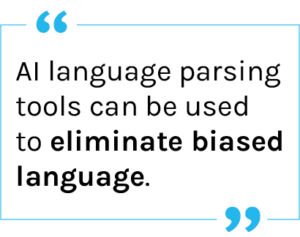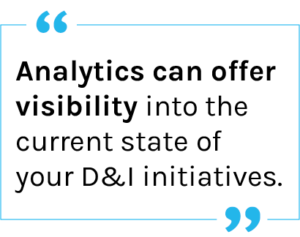How AI and other technologies can further D&I initiatives throughout the employee lifecycle

Diversity, equity, and inclusion are top of mind for many organizations today, including HigherEd institutions. Building a diverse workforce is essential: evidence shows that diverse companies are more competitive. For higher education institutions, a diverse faculty and staff is also vital to achieving the institution’s academic mission. According to the Higher Education Recruitment Consortium, “educating people of all backgrounds, beliefs, and cultures requires a diverse academic workforce.” With the recruiting and analytic technologies available today, human resources teams can take action and drive D&I efforts at their institutions.
AI and Technology in Recruiting
Advances in artificial intelligence are being applied to recruiting and hiring practices at companies across industries: 43% of D&I technologies are used for talent acquisition. There are many opportunities in the recruiting process where technology can help institutions further their D&I initiatives.
Some available products use AI to identify bias in job descriptions. Such technologies can find exclusionary language that only applies to a narrow candidate pool, like phrases that are typically masculine and discourage women from applying for a role, and can even suggest alternative language for employers to use. Refining job descriptions and maintaining an up-to-date library of those descriptions is an important part of a successful recruitment marketing strategy, but also of ensuring that your advertised roles attract a diverse candidate pool.
Once you have the right job description, it’s important that you get it in front of the people you want to recruit. With PeopleAdmin’s Marketplace of Connectors, you can easily share your open position with a wide range of job boards and social media platforms.
It can also help reduce unconscious bias once you’ve posted your open role. Some technologies can show hiring teams blind resumes, with all information except skills removed, or search resumes in a database for certain skills or attributes, like gender. Other companies have developed assessments to seek out sometimes overlooked candidates based on “soft skills” — including internal candidates who could “upskill” into a position.
information except skills removed, or search resumes in a database for certain skills or attributes, like gender. Other companies have developed assessments to seek out sometimes overlooked candidates based on “soft skills” — including internal candidates who could “upskill” into a position.
Don’t overlook AI in the interview process itself! AI has made its way into candidate screening, with technology designed to analyze video interviews and candidate responses to questions, with the goal of eliminating human bias in the first step of the interview process. In addition, AI language parsing tools can be used to eliminate biased language in interview questions as well as in your job descriptions.
Development, Engagement, and Retention
Once an employee is through your doors, the D&I work can’t stop. Again, technology can support this effort. Offering extensive professional development programs for employees, including diversity trainings and mentorship and networking opportunities, is an important aspect of promoting inclusive practices and retaining diverse employees at your institution. Technology has taken experiences like diversity training to new levels; virtual reality can make programs more immersive and effective. A learning management platform that offers easy visibility for faculty and staff to track their progress can be an important part of a robust professional development program.
Artificial intelligence can also support engagement and retention: some programs can analyze your institution’s written internal communications for bias and exclusionary language, helping you improve the employee experience.
Analytics Capabilities
 Access to data and D&I analytics is perhaps the most important aspect of D&I technology. Analytics can offer visibility into the current state of your D&I initiatives and the work that still needs to be done. Data can help in identifying pay gaps, understanding demographic breakdowns in your institution, and monitoring employee retention and engagement. See where your current initiatives are succeeding or falling short and recognize the places where you need to push further. Data visibility is also important, and PeopleAdmin’s Analytics module can support your team. From the holistic view of the HR office to a specific report for a department head, you can monitor progress institution-wide.
Access to data and D&I analytics is perhaps the most important aspect of D&I technology. Analytics can offer visibility into the current state of your D&I initiatives and the work that still needs to be done. Data can help in identifying pay gaps, understanding demographic breakdowns in your institution, and monitoring employee retention and engagement. See where your current initiatives are succeeding or falling short and recognize the places where you need to push further. Data visibility is also important, and PeopleAdmin’s Analytics module can support your team. From the holistic view of the HR office to a specific report for a department head, you can monitor progress institution-wide.
Final Thoughts
Technology can help your HR team, and your institution, take its D&I initiatives into the future. With tools that focus on diversity and inclusion in talent acquisition and employee growth and retention, along with the increased visibility of and access to data analytics, your HigherEd institution can become a leader in diversity and inclusion in the workplace.